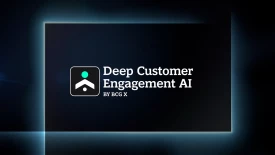Your people need to get excited about how the latest tech can help them succeed. Our Deploy play gets employees using the technology as soon as possible—a critical first step towards realizing value from GenAI.
Deploy, Reshape, Invent
Boost performance, transform core functions, and innovate at top speed. Part of a broader approach to AI and GenAI, BCG's DRI strategy helps drive substantial strategic value. Learn more about these three interconnected value plays from three BCG experts.
Video
September 12, 2024
Deploy GenAI in Everyday Tools
Featured Expert:
Julie Bedard
Your people need to get excited about how the latest tech can help them succeed. Our Deploy play gets employees using the technology as soon as possible—a critical first step towards realizing value from GenAI.
Your people need to get excited about how the latest tech can help them succeed. Our Deploy play gets employees using the technology as soon as possible—a critical first step towards realizing value from GenAI.
Video
September 12, 2024
Reshape Critical Functions
Featured Expert:
David Martin
End-to-end AI transformation is within reach—but if you think too small, you’ll come up short. Our Reshape play reimagines entire functions to deliver the cost savings and greater ROI that AI makes possible.
End-to-end AI transformation is within reach—but if you think too small, you’ll come up short. Our Reshape play reimagines entire functions to deliver the cost savings and greater ROI that AI makes possible.
Video
September 12, 2024
Invent New Business Models
Featured Expert:
Beth Viner
With AI, innovation can move at a pace you’ve never seen before, bringing new products and businesses to your organization. Our Invent play is a chance to find growth opportunities that you may never have found otherwise.
With AI, innovation can move at a pace you’ve never seen before, bringing new products and businesses to your organization. Our Invent play is a chance to find growth opportunities that you may never have found otherwise.
The Expansive Power of Generative AI
What Is Generative AI?
To gain a competitive edge, business leaders first need to understand what generative AI is.
Generative AI is a set of algorithms, capable of generating seemingly new, realistic content—such as text, images, or audio—from the training data. The most powerful generative AI algorithms are built on top of foundation models that are trained on a vast quantity of unlabeled data in a self-supervised way to identify underlying patterns for a wide range of tasks.
For example, GPT-3.5, a foundation model trained on large volumes of text, can be adapted for answering questions, text summarization, or sentiment analysis. DALL-E, a multimodal (text-to-image) foundation model, can be adapted to create images, expand images beyond their original size, or create variations of existing paintings.
Generative AI is a set of algorithms, capable of generating seemingly new, realistic content—such as text, images, or audio—from the training data. The most powerful generative AI algorithms are built on top of foundation models that are trained on a vast quantity of unlabeled data in a self-supervised way to identify underlying patterns for a wide range of tasks.
For example, GPT-3.5, a foundation model trained on large volumes of text, can be adapted for answering questions, text summarization, or sentiment analysis. DALL-E, a multimodal (text-to-image) foundation model, can be adapted to create images, expand images beyond their original size, or create variations of existing paintings.
What Can Generative AI Do?
These new types of generative AI have the potential to significantly accelerate AI adoption, even in organizations lacking deep AI or data-science expertise. While significant customization still requires expertise, adopting a generative model for a specific task can be accomplished with relatively low quantities of data or examples through APIs or by prompt engineering. The capabilities that generative AI supports can be summarized into three categories:
- Generating Content and Ideas. Creating new, unique outputs across a range of modalities, such as a video advertisement or even a new protein with antimicrobial properties.
- Improving Efficiency. Accelerating manual or repetitive tasks, such as writing emails, coding, or summarizing large documents.
- Personalizing Experiences. Creating content and information tailored to a specific audience, such as chatbots for a personalized customer experiences or targeted advertisements based on patterns in a specific customer's behavior.
How Is Generative AI Governed?
Generative AI systems are democratizing AI capabilities that were previously inaccessible due to the lack of training data and computing power required to make them work in each organization’s context. The wider adoption of AI is a good thing, but it can become problematic when organizations don’t have appropriate governance structures in place.
The Ethical Issues Tied to Generative AI Governance
As users experiment with these systems, there are serious ethical issues that need to be addressed:
The Ethical Issues Tied to Generative AI Governance
As users experiment with these systems, there are serious ethical issues that need to be addressed:
- Unknown Capabilities. Large generative AI systems such as ChatGPT have exhibited a massive capability overhang—skills and dangers that are not planned for in the development phase and are generally unknown and unexpected even to the developers. This can pose a serious threat if the right guardrails are not in place to effectively manage unexpected usage.
- Bias and Toxicity. Outputs from generative AI will be as biased as the data it is trained on. Many popular language models today are trained on the wilds of the internet, where there is plenty of bias—along with toxic language and ideas.
- Data Leakage. Many companies have quickly put policies in place to forbid employees from entering sensitive information into ChatGPT, fearing that it could get incorporated into the AI model and reemerge in public.
- Hallucination. ChatGPT can make arguments that sound extremely convincing but are 100% wrong. Developers refer to this as “hallucination,” a potential outcome that limits the reliability of the answers coming from AI models.
- Lack of Transparency. Generative AI models currently provide no attribution for the facts underlying the content they generate, which makes it impossible to verify the correctness of generated claims—further increasing the danger posed by AI-model hallucinations.
- Copyright Controversies. Since the data sets used by AI models are derived from the public internet, a legal question arises: Does the content those models create amount to duplications of copyrighted works?
What Are the Types of Generative AI Models?
Types of Text Models
- GPT-3, or Generative Pretrained Transformer 3, is an autoregressive model pre-trained on a large corpus of text to generate high-quality natural language text. GPT-3 is designed to be flexible and can be fine-tuned for a variety of language tasks, such as language translation, summarization, and question answering.
- LaMDA, or Language Model for Dialogue Applications, is a pre-trained transformer language model to generate high-quality natural language text, similar to GPT. However, LaMDA was trained on dialogue with the goal of picking up nuances of open-ended conversation.
- LLaMA is a smaller natural language processing model compared to GPT-4 and LaMDA, with the goal of being as performant. While also being an autoregressive language model based on transformers, LLaMA is trained on more tokens to improve performance with lower numbers of parameters.
- GPT-4 is the latest release of GPT class of models, a large-scale, multimodal model which can accept image and text inputs and produce text outputs. GPT-4 is a transformer-based model pretrained to predict the next token in a document. The post-training alignment process results in improved performance on measures of factuality and adherence to desired behavior.
- DALL-E is a type of multimodal algorithm that can operate across different data modalities and create novel images or artwork from natural language text input.
- Stable Diffusion is a text-to-image model similar to DALL-E, but uses a process called “diffusion” to gradually reduce noise in the image until it matches the text description.
- Progen is a multimodal model trained on 280 million protein samples to generate proteins based on desired properties specificized using natural language text input.
What Type of Content Can Generative AI Text Models Create—and Where Does It Come From?
Generative AI text models can be used to generate texts based on natural language instructions, including but not limited to:
- Generate marketing copy and job descriptions
- Offer conversational SMS support with zero wait time
- Summarize text to enable detailed social listening
- Search internal documents to increase knowledge transfer within a company
- Condense lengthy documents into brief summaries
- Power chatbots
- Perform data entry
- Analyze massive datasets
- Track consumer sentiment
- Writing software
- Creating scripts to test code
- Find common bugs in code
How Is Generative AI Beneficial for Businesses?
Generative AI has massive implications for business leaders—and many companies have already gone live with generative AI initiatives. In some cases, companies are developing custom generative AI model applications by fine-tuning them with proprietary data.
The benefits businesses can realize utilizing generative AI include:
The benefits businesses can realize utilizing generative AI include:
- Expanding labor productivity
- Personalizing customer experience
- Accelerating R&D through generative design
- Emerging new business models
What Are the Industries That Benefit from Generative AI?
Generative AI technology will cause a profound disruption to industries and may ultimately aid in solving some of the most complex problems facing the world today. Three industries have the highest potential for growth in the near term: consumer, finance, and health care.
- Consumer Marketing Campaigns. Generative AI can personalize experiences, content, and product recommendations.
- Finance. It can generate personalized investment recommendations, analyze market data, and test different scenarios to propose new trading strategies.
- Biopharma. It can generate data on millions of candidate molecules for a certain disease, then test their application, significantly speeding up R&D cycles.
How Business Leaders Can Get Started with Generative AI
Executives should work with their data engineers to identify creative ways to discover new generative AI solutions and assess which solutions are likely to bring the most value to the company. Generative AI is still in its infancy and companies must think outside the box to identify unique or hidden applications that will provide unique competitive advantage.
To get started experimenting to find new use cases, leaders need to ask themselves four questions:
To get started experimenting to find new use cases, leaders need to ask themselves four questions:
- Where do we have underutilized data that is critical for our business functions?
- Can this data be easily used to fine-tune an existing generative AI model?
- Can we transform this data into another format (from numerical data to visual data, for example) to leverage existing generative AI systems?
- What outputs do we expect and where in our organization could these outputs be used?

Our Client Impact with Generative AI
Video
September 30, 2024
Working with BCG, Commvault has improved time to closure of projects while handling customer data responsibly and solving problems. Here's how.
Video
September 5, 2024
Empowering an Insurance Leader Through GenAI
New York Life partnered with BCG to see how GenAI, coupled with transformational governance, could deliver exceptional experiences as well as efficiencies across the enterprise—furthering the company’s growth and advancement as an industry leader.
AI Agents
With the ability to observe, plan, and act autonomously, AI agents open a new chapter of end-to-end transformation across industries.
Our Generative AI Products

Deep Customer Engagement AI by BCG X
As part of Deep Customer Engagement AI by BCG X’s end-to-end customer transformation, our GenAI accelerators help clients revolutionize their customer service operations.
Deep Customer Engagement AI by BCG X

ARTKIT
ARTKIT is BCG X’s open-source toolkit for red teaming new GenAI systems, enabling data scientists, engineers, and business decision makers to quickly develop and launch fully reliable, enterprise-scale solutions.
ARTKIT
Our Latest Generative AI Collaborations
BCG Announces GenAI Collaboration with Merck
We are proud to announce a strategic collaboration with Merck aimed at advancing the discovery and assessment of novel drug targets for chronic and degenerative diseases through AI.
Press Release
April 18, 2024
BCG Announces Collaborations with NASA and USRA
We are privileged to work with NASA’s Ames Research Center and the Universities Space Research Association (USRA) to launch a GenAI lab for science and engineering.
Additional Generative AI Collaborations
BCG Executive Perspectives 2024
We meet often with CEOs to discuss AI—a topic that is both captivating and rapidly changing. Drawing on our experience with thousands of AI programs, we are sharing a series of playbooks designed to help senior executives navigate their AI transformation journeys and turn AI’s potential into real profit.
Our Latest Insights on Generative AI
Video
March 12, 2025
Love, Trust, and Marketing in the Age of AI
BCG's Amaryllis Liampoti presents three foundational principles for how brands can harness AI to enhances lives without undermining human agency.

Article
January 15, 2025
AI remains a top priority for business leaders worldwide in 2025, with a strong focus on generating tangible results, according to BCG’s survey of C-suite executives.

Article
November 20, 2024
BCG’s new AI Maturity Matrix combines an economy’s exposure to AI with its readiness to handle AI disruption. Explore our assessment of 73 economies.

Article
November 7, 2024
Even with comprehensive testing and evaluation, the risk of system failure with GenAI will never be zero. Organizations must respond swiftly when failures inevitably occur.
Video
September 22, 2024
GenAI is an Exoskeleton that Boosts the Capabilities of Knowledge Workers
Developing an engineering mindset can amplify the power of generative AI for analytics, says BCG’s Daniel Sack.
Video
September 9, 2024
Extending our existing partnership around AI, BCG and BMW are now partnering with AWS, BCG X, and BCG Platinion to ensure a secure, scalable integration of GenAI.
Meet Our Generative AI Experts
BCG’s generative AI experts have deep experience in AI technology, neural networks, generative models, the benefits of generative AI, and more. Here are some of our experts in generative AI.



















